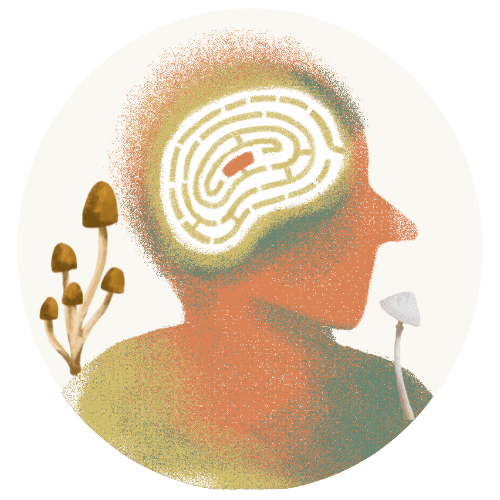Psilocybin Mushrooms

Psilocybin mushrooms, often called "magic mushrooms," have been revered for millennia as tools for healing, insight, and spiritual connection. Unlike synthetic psychedelics, these fungi offer an organic, earth-grown journey that many describe as deeply introspective and emotionally expansive.
At Places to Trip, we approach psilocybin with respect—honoring its power to reveal hidden layers of consciousness while emphasizing the importance of intentional use. When paired with the right setting, mushrooms can facilitate profound personal breakthroughs, creative inspiration, and a renewed sense of connection to nature.
History
Psilocybin’s human history stretches back to ancient Mesoamerican cultures, where Aztec and Maya civilizations referred to them as teonanácatl ("flesh of the gods"). Indigenous rituals used mushrooms for divination, healing, and rites of passage. Western science took notice in the 1950s when ethnomycologist R. Gordon Wasson documented Mazatec mushroom ceremonies in Mexico, sparking academic and countercultural interest. By the 1960s, psilocybin entered psychedelic research—until prohibition halted studies for decades. Today, modern science is rediscovering what traditional societies long understood: these fungi have unique potential for mental health and personal growth.
Effects
Psilocybin’s effects unfold in waves, blending sensory enhancement with deep emotional and cognitive shifts. Colors may appear more vibrant, patterns might flow like living art, and time can feel elastic. Many users report ego dissolution—a temporary loss of self-boundaries that can lead to feelings of unity with nature or the universe. Emotions often surface intensely, sometimes bringing unresolved thoughts into clear focus. Unlike stimulants, mushrooms tend to invite surrender rather than energy; lying on grass under trees is as common as philosophical discussions. At higher doses, visions and mystical experiences are possible, though individual responses vary widely.
Duration
A typical mushroom journey lasts 4–6 hours, with effects beginning 30–60 minutes after ingestion (faster on empty stomachs). The peak arrives around 1.5–2 hours in, characterized by the most intense visual and cognitive effects. Gradual tapering begins around hour 3, often leaving users in a reflective, emotionally open state. Residual effects—like enhanced color perception or mental clarity—can linger for several hours post-trip. Unlike LSD, mushrooms rarely produce extended "afterglow" fatigue, making them gentler for next-day integration.
Medical Uses
Clinical trials at Johns Hopkins, Imperial College London, and elsewhere show psilocybin’s promise for:
- Treatment-resistant depression (single doses sometimes bringing months of relief)
- End-of-life anxiety in terminal patients
- Addiction cessation (especially tobacco and alcohol)
- OCD and PTSD symptom reduction
Therapy models emphasize guided sessions with intentional preparation and integration—a framework we extend to mindful recreational use.
Risks & Side Effects
While physically non-toxic and non-addictive, mushrooms demand respect:
- "Bad trips" (acute anxiety/paranoia) are possible with high doses or poor settings
- Nausea is common during onset, especially with whole mushrooms (teas or extracts may reduce this)
- Vulnerability to suggestion makes set/setting critical
- Contraindications: Those with personal/family history of psychosis should avoid psilocybin
Safer-Use Practices
- Start low (1–1.5g dried for beginners; 2–3.5g for experienced users)
- Have a sober sitter in unfamiliar settings
- Avoid mixing with alcohol, stimulants, or MAOIs
- Choose natural settings with escape routes (forests > crowded cities)
- Fast 4–6 hours beforehand to reduce nausea
Legality Awareness
- Decriminalized in parts of the U.S. (Oregon, Colorado, some California cities)
- Legal psilocybin truffles in the Netherlands
- Illegal but culturally tolerated in parts of Mexico and Jamaica
- Most countries still prohibit possession—know local laws before traveling
Set & Setting Intro
Mushrooms amplify their environment—a sunlit meadow can feel like a benevolent classroom, while a chaotic apartment might morph into a labyrinth of anxiety. We recommend:
- Nature: Forests, gardens, or quiet beaches (avoid remote areas alone)
- Comfortable interiors: Soft lighting, blankets, curated playlists
- Trusted company: Small groups or solo, but never with strangers
- Intentional timing: Daylight for first-timers; nighttime only if experienced
